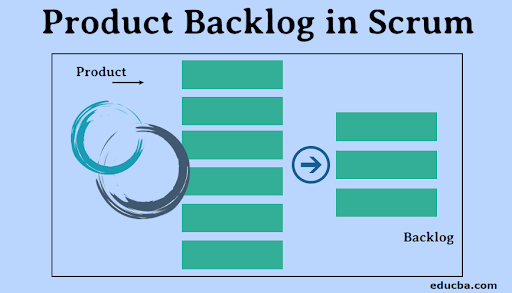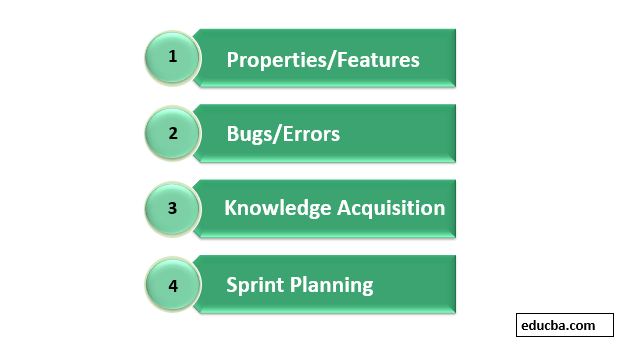
Introduction to Product Backlog in Scrum
Product backlog in scrum is defined as the list of customer-centric detailed functionalities and descriptions, changes, and adjustments made to the product during the project completion cycle. The documented list of all the requirements and the potential changes made to the product throughout the delivery process. There is a product backlog in agile and scrum project management methodology. Thus the maintained in scrum is called Scrum Product Backlog. In the scrum Project management and product backlog management, lengthy and upfront documentation of the project is not required, unlike the typical conventional product backlogs. In Scrum, the focus is on what to do rather than how to do it, which makes it more efficient than any other project management technique.
The scrum can be maintained by the product owner and the scrum team together by listing and prioritizing the requirements for backlog creation and prioritization. The product backlog is maintained in the form of sprints, and there are continuous changes, additions, and deletions to the initial in scrum until the product is delivered to the client or the stakeholder. During the product development lifecycle, feedbacks are collected from the customer for making changes and improving them. Thus the tends to grow more and more till the product is delivered.
Difference between a Simple List and a Scrum Product Backlog
List of features that differentiates it from the traditional simple to-do list:
- It signifies a living document in which the entries are being added until the project is completed. The meaning of a living document is dynamic in nature and keeps changing as various entries are added to the scrum product backlog on a real-time basis. Therefore, the changes or the requirements in the scrum product backlog may be iterative as per the need of the project.
- The entries or the amendments added in corresponds to the customer feedback or customer value. If there is no customer value corresponding to the entry in the scrum product backlog, then it is merely a waste. The customer value can either be technical or non-technical requirements or any details required to complete the product. These customer values are also required for enhancing or improving the quality of the product or the deliverable.
- The task or the entries in the scrum are low-level tasks that are basically no action items. Therefore, it does not comprise a detailed description of the task. The scrum team handles the distribution of the task and the work breakdown of these tasks as scrum is listing down the task and entries, so it does not make any sense to put in loads of time by mentioning the detailed description of the entries in the product backlog.
- The tasks are prioritized based on the product owner’s requirements. The product owner decides the prioritization of the task, and the scrum team is responsible for carrying out the task as per the prioritization decided by the owner.
- The task details are solely dependent on their position in the scrum.
Essential Components of a Typical Scrum Product Backlog
Following are the essential components:
1. Properties/Features
The features are defined as the user stories that depict the entries’ functionality and describe the customer perspective in simple words.
2. Bugs/Errors
As a product is developed in different phases and these phases undergo testing, different bugs or errors or improvements are collected and added to the scrum to be rectified in the next product development phase.
3. Knowledge Acquisition
Knowledge acquisition is very important in management as it makes the selection and decision-making process easy and also helps to create a library of processes for further reference.
4. Sprint Planning
The product owner leads the sprint planning and meeting, and the works/tasks are prioritized in this sprint meeting. The product owner and the scrum team then decide the order or sequence of the task to be completed. Thus, new entries and tasks are added timely as per the project’s requirement, making the product backlog dynamic and expandable in nature.
How does the Scrum Product Backlog Works?
Scrum management is a very precise process and needs to be maintained carefully. The first and basic step is to plan a sprint meeting led by the product owner and then writing or listing down the tasks or requirements of the product or project. Gradually expands, and new entries/tasks are added to the backlog. Also, certain old tasks are removed on a per requirement basis. These tasks are then ordered or arranged as per the urgency or priority described by the product owner. These tasks are then divided into different sprints, or in simpler words, a work breakdown structure is created, and the work is distributed among the scrum team. The product owner is provided with the regular update of the tasks completed as per the product, and also, these are changed and maintained regularly in the scrum, making for documentation updated.
Perks and Benefits
- As the tasks are listed and prioritized in the scrum, the product is delivered or completed efficiently and on time in an organized manner.
- A large project is divided into smaller sprints/phases/modules for making the work easy and less time-consuming.
- Regular scrum meetings help to understand the product owner’s perception clearly, and thus these scrum gives a clear insight into the project requirements.
- The maintenance helps to save time and unnecessary money wastage as it helps to remove all the potential threats causing a delay in product delivery.
- It allows customer feedback inclusions for improvisation at different stages and sprints while making it agile and flexible.
- Well suited for agile and dynamic development projects during which the product is developed and tested as the mandatory steps for the retrospection and review process.
Recommended Articles
This is a guide to the Product Backlog in Scrum. Here we discuss the difference between a Simple List and a Scrum Product Backlog, along with the Essential Components of a Typical Scrum Product Backlog. You may also look at the following articles to learn more–


